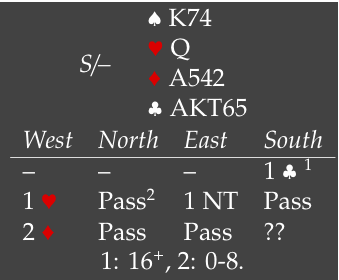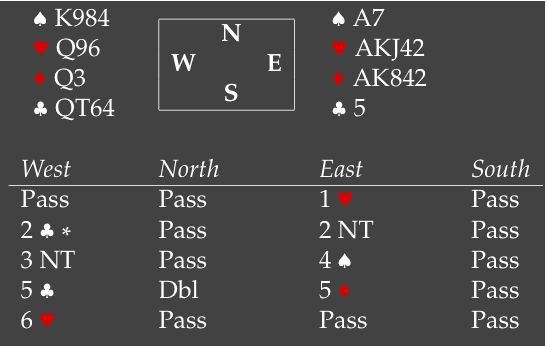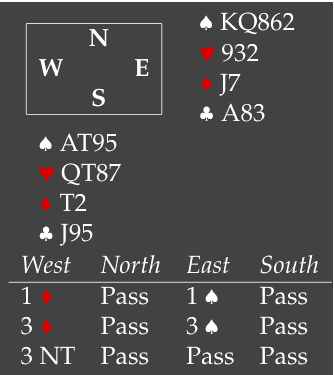 Last Saturday, junior coach Kees Tammens organized a training session at “de Denktank” in Arnhem. 15 junior pairs who will represent the Netherlands at various junior events this summer showed up. The juniors played NS, with coaches Kees and Marleen van de Sande watching and taking notes about areas that needed improvement. The EW seats were taken by the better players from the local clubs “de Denktank” and “Interbridge”. As this was a training event, the hands were selected from old matches that Kees had played himself when he was still an active player at the highest level. Throw in a bidding contest before lunch and some chinese food between the two sessions, and you have all the ingredients for fun day. And it is, of course, good to see that we have a bunch of junior pairs eager to spend a sunny Saturday in a holiday weekend in order to improve their game. (For another report on the event, click here or here).
Last Saturday, junior coach Kees Tammens organized a training session at “de Denktank” in Arnhem. 15 junior pairs who will represent the Netherlands at various junior events this summer showed up. The juniors played NS, with coaches Kees and Marleen van de Sande watching and taking notes about areas that needed improvement. The EW seats were taken by the better players from the local clubs “de Denktank” and “Interbridge”. As this was a training event, the hands were selected from old matches that Kees had played himself when he was still an active player at the highest level. Throw in a bidding contest before lunch and some chinese food between the two sessions, and you have all the ingredients for fun day. And it is, of course, good to see that we have a bunch of junior pairs eager to spend a sunny Saturday in a holiday weekend in order to improve their game. (For another report on the event, click here or here).
Some of the more interesting hands from the day, scoring is match-points, the skills of the opponents range from just having switched from minibridge to real bridge to junior world champions.
 Nobody vulnerable, you open a Precision club (16+, almost any distribution) in first seat and the auction proceeds as follows. Your turn to bid something?
Nobody vulnerable, you open a Precision club (16+, almost any distribution) in first seat and the auction proceeds as follows. Your turn to bid something?
 Vulnerable against not, you pick up this collection. Partner is an expert player but you haven’t played with him before. First, is this an opening bid and if so what? If you think the hand is too flawed for any of the preempts, the bidding starts with 1♣ on your left, pass from partner, 1♥ on your right. Your turn?
Vulnerable against not, you pick up this collection. Partner is an expert player but you haven’t played with him before. First, is this an opening bid and if so what? If you think the hand is too flawed for any of the preempts, the bidding starts with 1♣ on your left, pass from partner, 1♥ on your right. Your turn?
 An opening lead problem. You and partner pass, the opponents bid a simple 1♥-2♥-4♥. 1♥ promises 5, 2♥ is constructive. Your lead?
An opening lead problem. You and partner pass, the opponents bid a simple 1♥-2♥-4♥. 1♥ promises 5, 2♥ is constructive. Your lead?
 You are in 6♥ on a club lead. 2♣ was Drury, 2NT showed any slam try, 3NT a balanced minimum, 4♠ asked for aces, 5♣ showed none, 5♦ asked for the ♥Q, 6♥ showed that card. South leads the ♣3, 3rd and 5th, ♣4, ♣K, ♣5. North returns a heart. Plan the play.
You are in 6♥ on a club lead. 2♣ was Drury, 2NT showed any slam try, 3NT a balanced minimum, 4♠ asked for aces, 5♣ showed none, 5♦ asked for the ♥Q, 6♥ showed that card. South leads the ♣3, 3rd and 5th, ♣4, ♣K, ♣5. North returns a heart. Plan the play.
 Partner leads the ♥5, 3rd and 5th, ♥2, ♥Q, ♥A. Back comes the ♠J, ♠4, ♠2 and it is your turn to play a card. Carding is standard, high-low showing an even number.
Partner leads the ♥5, 3rd and 5th, ♥2, ♥Q, ♥A. Back comes the ♠J, ♠4, ♠2 and it is your turn to play a card. Carding is standard, high-low showing an even number.
Solutions, as usual, later in the week.
 Finally, some correspondence about this hand that I discussed last week. You are in 4♠ after 1♠-2♥-2♠-3♥; 4♠ on the lead of a high heart. At the table, my opponent ruffed the lead, crossed to the ♦J and took a spade finesse. When that was off and another heart was lead, she eventually lost control over the hand. I said that, with the likely force in hearts, it was better to cash the ♠AK, then play diamonds, discarding clubs from the dummy. The person with the 3rd trump will eventually ruff a diamond, but after that, you can ruff 3 hearts in hand and a club in the dummy, with the 2 top spades, 3 diamonds and ♣A, that makes 10 tricks. As several readers pointed out, this line of play does not work if west refuses to ruff any of the diamonds. After the fourth round, you have to play the ♣A and a club. The opponent with the remaining spade can win the trick, draw the remaining trump and cash hearts. This is correct. With the actual layout, declarer can prevent this by ducking the first round of clubs to east, but in general, it is better to cross to the ♦J, ruff a heart, cash 2 more diamonds, cross to the ♣A, ruff another heart. Now play the ♠AK and continue with the remaining diamond. You score the same tricks but avoid that the opponents can draw trumps. There are some variations on this line possible, that all lead to essentially the same tricks.
Finally, some correspondence about this hand that I discussed last week. You are in 4♠ after 1♠-2♥-2♠-3♥; 4♠ on the lead of a high heart. At the table, my opponent ruffed the lead, crossed to the ♦J and took a spade finesse. When that was off and another heart was lead, she eventually lost control over the hand. I said that, with the likely force in hearts, it was better to cash the ♠AK, then play diamonds, discarding clubs from the dummy. The person with the 3rd trump will eventually ruff a diamond, but after that, you can ruff 3 hearts in hand and a club in the dummy, with the 2 top spades, 3 diamonds and ♣A, that makes 10 tricks. As several readers pointed out, this line of play does not work if west refuses to ruff any of the diamonds. After the fourth round, you have to play the ♣A and a club. The opponent with the remaining spade can win the trick, draw the remaining trump and cash hearts. This is correct. With the actual layout, declarer can prevent this by ducking the first round of clubs to east, but in general, it is better to cross to the ♦J, ruff a heart, cash 2 more diamonds, cross to the ♣A, ruff another heart. Now play the ♠AK and continue with the remaining diamond. You score the same tricks but avoid that the opponents can draw trumps. There are some variations on this line possible, that all lead to essentially the same tricks.
